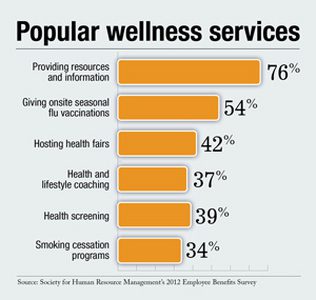Final Wellness Incentive Rule Released. Final rules set forth the criteria for wellness programs offered in connection with group health plans that must be satisfied in order for the plan to qualify for an exception to the prohibition on discrimination based on health status under the federal Health Insurance Portability and Accountability Act (HIPAA). The final rules will be effective for plan years beginning on or after January 1, 2014.
Many employers already offered incentives for employees participating in wellness programs. The main change in the new rule is an increase in the maximum incentive levels for several PPACA designated programs. For smoking cessation efforts, employers will be allowed to offer a reward or penalty of up to 50% of an employee’s health plan cost. For all other wellness programs, the number will be 30%, up from the current 20%. These increases are intended to promote healthy behavior which in turn, advocates claim, reduce health care spending.
Key Highlights
Significant provisions included in the final rules include:
Increasing the maximum permissible reward under a health-contingent wellness program, from 20% to 30% of the cost of coverage;
- Further increasing the maximum permissible reward for wellness programs designed to prevent or reduce tobacco use, from 20% to 50% of the cost of coverage; and
- Clarifications regarding the reasonable design of health-contingent wellness programs and the reasonable alternatives they must offer in order to avoid prohibited discrimination.
Types of Participatory Wellness Programs
The final rules continue to divide wellness programs into two categories:
1)”participatory wellness programs,” which are a majority of wellness programs,
2)and “health-contingent wellness programs.”
A participatory wellness program is one that either does not provide a reward or does not include any conditions for obtaining a reward that are based on an individual satisfying a standard related to a health factor. These include programs that reimburse for the cost of membership in a fitness center; provide a reward to employees for attending a monthly, no-cost health education seminar; or reward employees who complete a health risk assessment, without requiring them to take further action.
Participatory wellness programs are generally permissible under the HIPAA nondiscrimination rules, provided they are available to all similarly situated individuals regardless of health status.
Health-Contingent Wellness Programs
In contrast, a health-contingent wellness program requires an individual to satisfy a standard related to a health factor to obtain a reward. This standard may be performing or completing an activity (an “activity-only wellness program”), or it may be attaining or maintaining a specific health outcome (an “outcome-based wellness program”).
Examples of health-contingent wellness programs include programs that provide a reward to those who do not use, or decrease their use of, tobacco, or programs that reward those who achieve a specified health-related goal, such as a specified cholesterol level, weight, or body mass index, as well as those who fail to meet such goals but take certain other healthy actions.
In order to qualify for an exception to the HIPAA nondiscrimination rules, health-contingent wellness programs must meet five additional standards related to frequency of opportunity to qualify; size of the reward; reasonable design; uniform availability and reasonable alternative standards; and notice of the availability of reasonable alternative standards.
Example
The final rule provides an example of how this reward/penalty might work:
An employer sponsors a group health plan. The annual premium for employee-only coverage is $6,000 (of which the employer pays $4,500 per year and the employee pays $1,500 per year). The plan offers employees a health-contingent wellness program with several components, focused on exercise, blood sugar, weight, cholesterol, and blood pressure. The reward for compliance is an annual premium rebate of $600…[T]he plan also imposes an additional $2,000 tobacco premium surcharge on employees who have used tobacco in the last 12 months and who have not enrolled in the plan’s tobacco cessation program (Those who participate…are not assessed the $2,000 surcharge).
The total of all the rewards (including the absence of a surcharge for participating in the tobacco program) is $2,600…which does not exceed the applicable percentage of 50% of the total annual cost of employee-only coverage ($6,000 x 50%=$3,000). Tested separately, the $600 reward for the wellness program [excluding] tobacco use does not exceed the applicable percentage of 30 percent of the total annual cost of employee-only coverage ($6,000 x 30%=$1,800).
In excellent article in the Atlantic – The Future of Getting Paid to Be Healthy “Incentive programs are not wellness programs,” said Dr. Ronald Goetzel, Director of Emory University’s Institute for Health and Productivity Research and President and CEO of The Health Project. “That can be a component, when done smartly, of a comprehensive program, but if that’s all your program is going to be, you’re going to fail miserably, and people are going to be resentful,” he explained. According to Goetzel — who has studied worksite wellness programs at large corporations such as Dow Chemical and Johnson & Johnson, and is being funded by the Centers for Disease Control and Prevention to study best practices in the field — incentive programs can help get people excited about health and keep them on track, but ultimately people’s habits will only change if they are given the resources to change them and if the workplace norms and environments change.
Without the other pieces to facilitate behavior change — healthy cafeterias, opportunities to exercise, flexible work hours, supportive leadership and middle managers, and health risk assessments and coaching — incentive programs will only penalize, not change, those who are least healthy.
For more information, you may review the final rules in their entirety. For MMS Corp previous blogs on wellness, click here. we will keep you posted on future PPACA wellness program opportunities. In the meantime, please visit to view past blogs and Legislative Alerts at https://360peo.com/feed.
The views expressed in this post do not necessarily reflect the official policy, position, or opinions of MMS Corp. This update is provided for informational purposes. Please consult with a licensed accountant or attorney regarding any legal and tax matters discussed herein.

